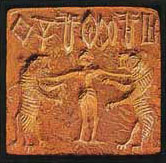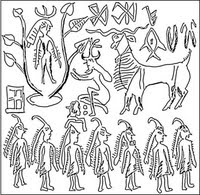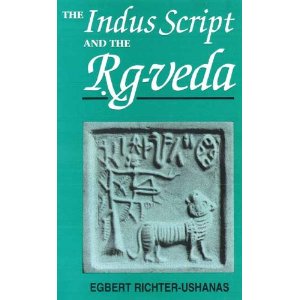Tiger Goddess of Indus Valley: Aryan or Dravidian?
Scholars who study Indus valley civilization are struggling to identify the Indus Valley Gods and goddesses. At present scholars don’t agree on their identification. They could not place them in the modern Hindu pantheon. They are fighting among themselves to name them as Aryan or Dravidian. Each scholar has his own or her own interpretation. All the confusion is the result of one Himalayan blunder of unprofessional archaeologists who identified the so called Pasupati seal with Proto Shiva. Unless and until the scholars come out of the Aryan Dravidian quagmire, the Indus Valley script can’t be deciphered.
Now look at the following Indus Gods and Goddesses and you yourself decide who is Aryan or Who is Dravidian who is Universal, Pan World:
TIGER GODDESS
A seal discovered in Mohenja-daro is at National Museum, Karachi(D392). This square seal depicts a tiger looking back a human figure on a tree. The person with hair tied in double bun style holds the tree with one hand and makes some gestures to the tiger with the other hand.
Another seal shows a tiger with a horn (DK 12897, Karachi Museum)
Photoconvex moulded tablet in Harappa museum shows a female figure fighting two tigers standing above an elephant ( I have interpreted this as Indra on Irawatha or Bharata who played with lions even when he was young. A chakra sign on top of the head may denote Indra’s name=chakra or Bharata= Eka Chakratipati). On the reverse we see a person spearing a buffalo. a figure seated in yogic position is looking at the buffalo sacrifice. A crocodile is above this scene.
On another seal a mythical female figure half human half tiger is portrayed .This seal is in national Museum ,New Delhi
A seal depicting a man holding a tiger was also found at Mohenja-daro. It is in Delhi Museum. The man fighting or holding the tiger is not an ordinary human being. It looks like a devil with horns.
What is puzzling is that there is not even a close resemblance to any of these scenes in our mythology. But villagers have got many stories about tiger gods or tiger angels in different parts of India. People living in forest areas naturally will have many juicy stories like this.
But who ever attributes the script to Aryan or Dravidian languages have failed to explain these seals satisfactorily. Then who is this Tiger Goddess or Tiger God? We have some contestants for this post.
Tiger Riders
Tribals in Indian jungles have different beliefs about tigers and tiger gods. When we look at the Indus seals with tiger men and tiger women we are reminded of these tribal stories. Kollong and Ullatar tribes of Kerala consider tiger as the son of goddess Parasakthi. They call the tigers, granddad. They rarely kill tigers. If the tigers kill many people and cattle, then one of the tribal will kill the tiger and asks for pardon in a public place. Then he has to live outside the village for a year and eat food given by others. This shows the respect they had for tigers. (Source 31-11-1963 article in Jayakeralam).
Tiger in Hinduism
Lord Ayyappa (Sabarimalai in Kerala, India) rides a tiger.
Hindu goddess Durga/Kali rides a tiger or lion.
Padmasambhava is worshipped in Tibet and Mongolia. He was the Indian ascetic who brought Buddhism to Tibet in 762 AD. He was shown riding a tiger.
Patanjali (Pulikkal Munivar) Human with legs of a tiger.
Shiva wears a tiger skin. Mahabharata very often uses the epithet “tiger among men”. People wear tiger nails in their chains. Vedas mention only hyena, not tigers.
The Brahmana literature describes Kshatriyas as tigers. Perhaps the four animals in the Pasupati seal means four castes of Hinduism.
Narasimhavatar: Half man, Half lion;Purusha Mrugam ; Sarabeswarar: Saraba bird+ man;Kim Purusha and Kinnara
Seven Women/ Sapta Kanya
Seven is the most sacred number for Hindus. Anything holy, they count in seven, whether it is hills, rivers, forests, cities, holy women or holy men to remember (sapta kanya, sapta nadhi, sapta Rishi, sapta mokshapuri, sapta aranya etc). Seven is found in largest number of seals in Indus valley. The Seven Sister seal in the Indus is a famous one. Most of the Hindu temples have Sapt Kanya/ seven women statues in South India. The story of Seven Sisters is there in several parts of the world from Australian aborigines to ancient Greeks. Mr Dave even identified seven birds in Rig Veda as seven sisters known to Bengalis (Bengalis call these seven birds as seven sisters).
Varunan with seven sisters is found in Rik Veda 8-41
Story from Australia:
Seven wandering ancestral heroines of the Dream time, also referred to their aboriginal name KUNGARANKALPA. The complete route of the sisters has been pieced together from stories told about them by different aboriginal clans living along its course. On reaching the southern coast, the seven sisters went in to the sea and then leaped in to the sky. Once in the sky they became the constellation KURIYALA (The Pleiades). Hindus call this six Krithikas. Westerners call this constellation Seven Sisters. This tallies somewhat with Hindu counting One Skanda+looked after by six sisters=seven).
Ancient San Rock paintings in South Africa have seven women as a group.
Take any Indus seal, we have parallel stories around the world to interpret it differently.
Human Sacrifice: Boora Pennu (God of light in Khond)
A local deity in the Orissa who created the earth goddess Tari Pennu as his consort is called Boora Pennu. Until recently this deity was the subject of sacrifice in notorious meriah rituals, which involved violent human sacrifice (reminds us of Mayan sacrifice)
Tari pennu in Tamil will mean the same. Tarai=earth or floor, pennu=woman.
But Tarai=terra-dharani are of Indo European origin.
A scene in a Mohenja daro seal also looks like a human sacrifice. A deity is depicted standing in a papal tree with bangles on both arms. A human head rests on a stool. A giant ram and seven figures in a procession are very prominent. A man in kneeling position is worshipping the papal deity. May be he has brought the ram for sacrifice. This seal is in Islamabad Museum.
For each and every seal found in Harappa and Mohenja daro, the scholars give different interpretations. Most of the scenes on seals are seen in other parts of the world too. So we need to piece them together and look at them from a different angle. The Pasupati seal (Deity surrounded by animals), the snake queen ( a deity with snakes on either side), a deity fighting two animals, arrangement of stones in a circle, Swastika symbol etc. are seen in different cultures. We have to find out who borrowed from whom. If they are universal there is no question of attributing them to Aryan or Dravidian.
Contact swami_48@yahoo.com or swaminathan.santanam@gmail.com
Please read my previous articles on Indus/Saraswati Valley civilisation:
Please read my earlier posts:1.Serpent Queen: From Indus Valley to Sabarimalai 2.Sugarcane Mystery: Indus valley and Ikshvaku Dynasty 3. Vishnu seal In Indus Valley 4. Indus Valley –New Approach required 5.Indra in Indus valley seals+ Symbols for Vedic Gods and 6.Ghost in Indus seals








You must be logged in to post a comment.